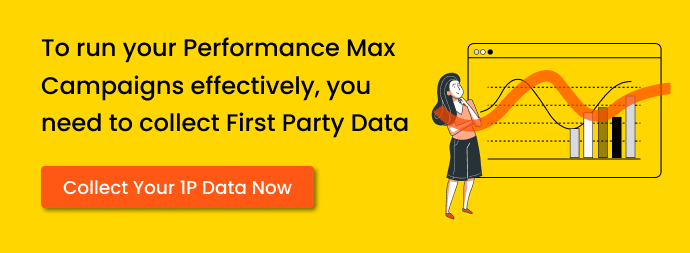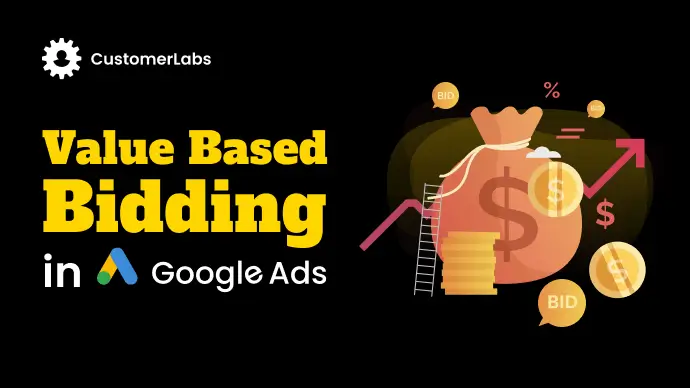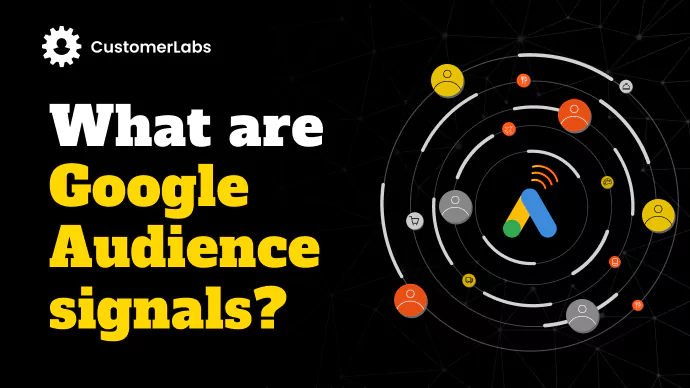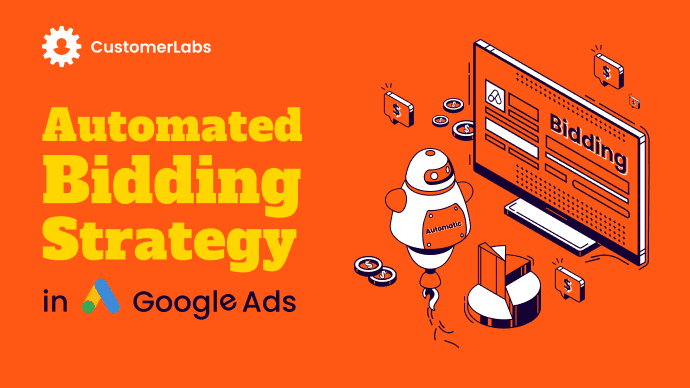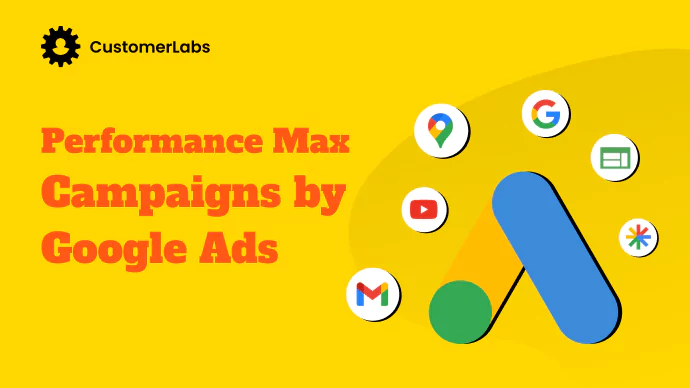
Struggling with which kind of campaign suits you the best? Wondering if you should go with display campaigns or search campaigns? What if Google gives you a special campaign where you can make your ad shown on search results as well as YouTube? That is exactly what Performance Max Campaigns does. It targets your audiences across all the available channels of Google Ads to find the most valuable conversions.
Google’s Journey…
Starting with Google Adwords in 2000, Google has radically transformed in the past two decades. Google Adwords introduced Remarketing in 2010, after successfully completing 10 years and to mark the second decade, it launched Performance Max Campaigns in 2020.
In the last 23 years, Google has introduced various campaigns such as the search ad campaigns, display ad campaigns, shopping campaigns, video ad campaigns, app campaigns, smart campaigns, local campaigns, and discovery campaigns. Finally, the umbrella of all these campaigns, the performance max campaigns.
PMax is evolving at a very rapid pace and Google is bringing in many changes very frequently in Performance Max.
What is Performance Max Campaign by Google Ads?
Performance Max or simply called the PMax campaigns is the special type of goal-based campaign launched by Google Ads to bring all the various campaigns under the single umbrella.
It allows advertisers to bid across Google Search & Display Networks with a single campaign. Either an ad on the video platform like youtube or the ad on discover, all can be managed using performance max campaigns to find the right audience across all the six channels of Google.
The six channels of Google include Search, Discover, YouTube, gmail, maps, and display network.
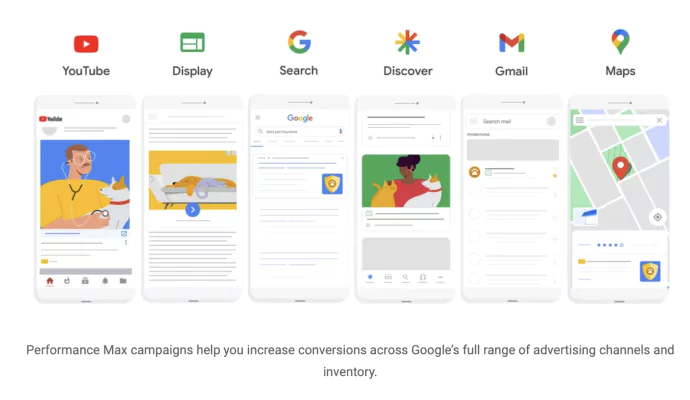
The name says it all…
As the name suggests, it is nothing but maximizing the performance of your ad campaigns.
The ads run across multiple channels and for sure might give you better results. To furthermore enhance the performance of your ads and reach out to the high-potential prospects, you have to consider performance max campaigns.
How do Performance Max Campaigns work?
The ad algorithm learns user behavior from the first party data and audience signals. It then tries to optimize your ad campaigns using this data.
By training itself, the algorithm tries to achieve the specified goal by optimizing your ad campaign performance in real-time to deliver maximum conversions and value by finding the high-prospect audience across the six channels using smart bidding.
How is the Performance Max different from other Google Ad Campaigns?
Google Performance Max Campaigns are different from other Google Ad Campaigns in various aspects & functionality and can be seen as below:
Ad Optimization: Other Ad Campaigns do not optimize the ads in real-time whereas the Performance Max Campaigns optimize the ad campaigns in real-time using data automation technology & machine learning.
Adaptability: Performance Max Ads target the audience by taking into account the changes in user behavior and other data signals. Therefore, it adapts to the user behavior and provides more personalization to the user helping you drive more conversions.
Advanced Tech: Other Ad campaigns do not use sophisticated approaches to deliver personalized ads while the Performance Max Ads do.
Reach & Visibility: The regular ad campaigns will not be able to focus on all the 6 Google channels at once and also have limited target audience. Whereas with Performance Max Campaigns, by providing few creative assets, you can make your ad reach across all the channels such as YouTube, Discover, Search, Maps, Gmail & Display Network.
The key distinction between a regular ad campaign and performance max ad campaigns is primarily ad automation, increased machine learning by Google Ads and to leverage more first-party data & cross-contextual audience signals.
Setting up Performance Max Campaigns:
Performance Max is said to be the next generation of local & shopping campaigns. For instance, when starting a new campaign if you choose your objective as ‘local store visits and promotions’, the only campaign type you get is Performance Max Campaign.
You can leverage the power of Performance Max Campaign when you choose:
- Sales as your objective
- Drive Traffic to your website as the goal
- Without any goal or objective
Choosing Performance Max Campaign gives you the advantage of specifying audience signals directly.
After choosing the goal/objective, and giving the campaign a name and clicking on next will land in the bidding strategy stage. Choose conversions or conversion value bid strategy and if needed, tCPA or tROAS.
Selecting the required options and proceeding will soon direct you to the Asset group. After uploading the required ad creatives, headline and other details, it will show the option Audience Signals.
Here’s where you have to create audience signals. Audience signals will act as the base point where the performance max starts finding the relevant target audience. Read our blog on Audience Signals to understand what audience signals are and how to leverage them to increase your ad campaign performance.
Performance Max Campaign is the only ad campaign where Google lets you create audience signals directly to leverage your own first-party data. In the other campaigns, although you provide first-party data and other signals, it does not mention them under the category audience signals.
Read the full blog on Google Audience Signals to know more.
Benefits of Performance Max Campaigns:
- Automate ad creation based on assets provided
- Increase the audience reach using audience signals
- Automate bidding process
- Display ads across the channels of Google to find customers wherever possible
- Place ads on multiple spaces using Dynamic ad formats
- Advanced URL expansion which sends traffic to the most relevant URLs of your website based on its performance in the real-time.
Quick Summary:
In short, Performance Max is the latest type of ad campaign that allows Google Ads advertisers to find the target audience across Gmail, YouTube, Search, Discover, Maps, and Google Display Network. It adopts advanced machine learning algorithms and automation to optimize the ad campaign performance in real-time.
Soon smart shopping campaigns and local campaigns are expected to be moved into Performance Max Campaigns to provide more value of automation to the users.
Leveraging Performance max campaigns will deliver:
More reach: You can reach your target audiences across all of Google’s channels, including Google Display Network (GDN).
Optimized Campaigns through Automated bidding: Your ad campaigns are optimized in real time to get the most out of your budget.
Personalized Ads: Using your audience signals through first-party data, performance max campaigns deliver personalized ads to your target audience.
Here are some additional tips:
- Use high-quality ad creative assets and text messages that capture your target audience’s attention.
- Use audience signals by collecting first-party data and syncing it without loss to Google Ads.
- Monitor your campaign performance to make required adjustments.
- Use Google Analytics to track your conversions and other key metrics.
Performance Max Campaigns are easy to set up and manage. All you have to do is provide your creative assets, relevant audience signals, and sit back to relax. Let Google do the rest.
We’ve spoken about how more good quality first-party data will drive Performance Max Campaigns.
But how much is more data?
Is it 15 conversions or 50 conversions or even 100 conversions?
I’ve come across a study by Mike Ryan, Head of eCommerce, Smarter Ecommerce. Upon comparing the monthly conversions, the average target ROAS (tROAS), and the actual ROAS. He then clustered them based on the number of conversions.
He then made a chart that showed how many campaigns
- have met the target ROAS,
- missed the target, and
- exceeded the target.
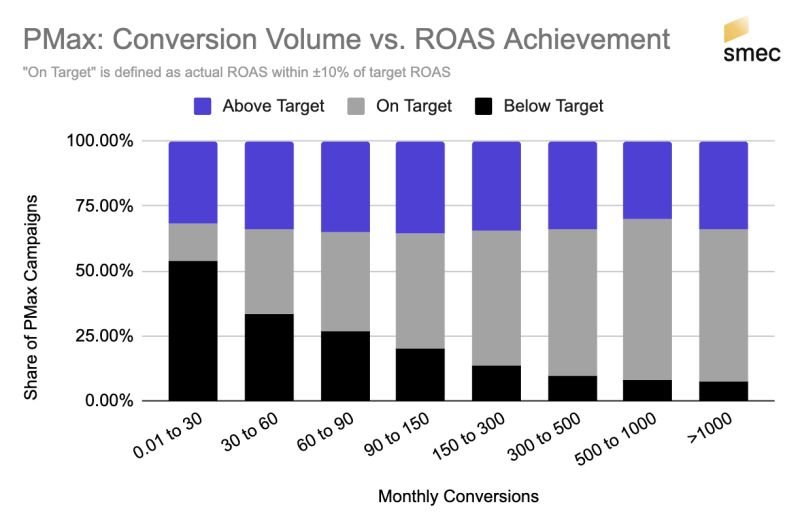
The chart shows how PMax campaigns perform when there are monthly conversions below 30. They have a high probability of missing the target ROAS. Therefore, if you come across anyone who tells you that 15 or 30 conversions are enough for PMax campaigns, do not just believe it. The above chart shows, the more the data, the better the performance.
Having at least 150 conversions will ensure that most of your campaigns either meet the target or exceed. Anything below that will not be economical.
Act wisely and act accordingly to boost your performance max campaigns.
Happy PMaxing!
